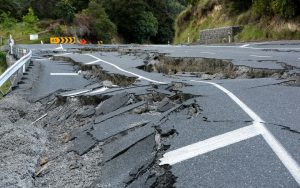20 April 2017-DENVER — The magnitude 7.8 Kaikoura earthquake that struck the South Island of New Zealand last November was the largest on-land recorded earthquake in the country’s history. In a special session at the 2017 SSA Annual Meeting, researchers gathered to describe their findings on the quake and its implications for further seismic activity in the region.

Shaking from the earthquake lasted about two minutes and 20 seconds, and was felt in the New Zealand capital of Wellington, about 260 kilometers away from the quake’s epicenter. Deformation of the sea floor off the coast of Kaikoura caused a tsunami that rose to about seven meters at its peak. The earthquake triggered about 80,000 landslides over an area of about 9000 square kilometers, according to research by the U.S. Geological Survey, which hopes to use data collected on the Kaikoura quake to improve models of earthquake-generated landslides and ground failure.
The Kaikoura quake is the fourth earthquake of magnitude 7 or larger to hit the region in the past seven years, which has seismologists suspecting that the earthquakes are connected in some way, write session chairs Bill Fry and Matt Gerstenberger of GNS Science.
One of the most unusual aspects of the Kaikoura earthquake was the widespread slow slip events (SSE) triggered by the main quake, said Gerstenberger and colleagues. Slow slip events are millimeters-small movements that occur over hours or months in subduction zones, where one tectonic plate slides beneath another. SSE have been detected in the New Zealand subduction zone before, but the Kaikoura earthquake appears to have sped up the rate of slip in some areas, produced simultaneous patches of slip in other areas, and triggered slip in other regions where no slow slip events have been previously detected-in this case, at a place where the far southern portion of a slice of oceanic crust called the Hikurangi Plateau is sliding underneath the Indo-Australian plate underlying New Zealand’s North Island. Seismologists are carefully monitoring these slow slip events, as they may increase the likelihood of other large earthquakes on the southern portion of North Island in the near future.
Ground faulting during the earthquake was very complex, rupturing at nine to 12 different faults with multiple orientations and overlaps, resulting in a combined rupture length of about 180 kilometers (nearly 112 miles), according to work by GNS Science’s Nicola Litchfield and colleagues. About half of the faults had been identified previously as active in a 2010 New Zealand National Seismic Hazard Model, Mark Stirling of the University of Otago and colleagues said, which had predicted a slightly smaller magnitude earthquake of 7.6 if a multi-fault earthquake were to occur.
Evidence from past seismic activity in the area suggests that earthquakes occur on these faults at intervals ranging from 300 to 400 years to many thousands of years, which indicate that the Kaikoura quake was a relatively rare event, Litchfield and colleagues note.
The unusual faulting of the earthquake also has researchers studying whether the quake was primarily a megathrust event, meaning that it was the kind of earthquake caused by one tectonic plate being forced under another at a subduction zone. However, the multiple surface-rupturing fault segments might suggest that the earthquake event was mostly restricted to strike-slip motion on the upper tectonic plate. In their SSA presentation, Penn State University’s Kevin Furlong and colleagues demonstrated how the surface faulting could be compatible with a megathrust event.
